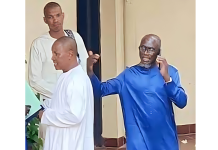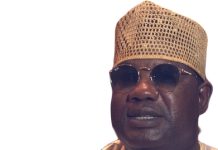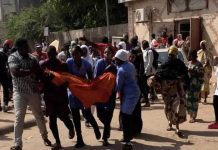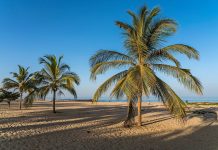By: Sheikh Alkinky Sanyang
The alternative livelihood component of the UNDP/GEF Coastal Resilience project is striving to ease Climate stress in affected local coastal communities whose farmlands and rice fields are affected by the phenomenon of Climate Change. A team of experts from different stakeholder institutions visited the 15 proposed intervention sites that are to benefit from the alternative livelihood component of the project.
These Gambian local experts were drawn from the Department of Forestry, Fisheries, Community Development and Agriculture with the aim of collecting first hand information from the beneficiaries and also give them the necessary technical advice they need in their different areas of intervention. They also looked at the viability of the project taking into consideration the possible social and environmental problems that may surface during the implementation of the project and have extensive salt intrusion problems into their production fields.
The communities to benefit from the project are Kombo Berending, Bintang, Bondali-Tenda, Kan-Manka in the West Coast Region, Misira, Karantaba, Janneh Kunda and Tendaba in the Lower River Region, Illiasa, Jajari, India, Salikenni, Kerewan, Dasilami and Tubab-Kolong in the North bank Region. The five climate-resilient alternative income-generating livelihood activities identified for the 15 communities will be trialed for a period of one year. The ultimate objective of the trial is to determine the feasibility of replicating the trialed activities to wider number of communities with similar problems.
The socio-economic situations of communities across the three regions covered by the study are similar and very much identical. The main livelihood of these communities is agriculture in which their main activities include growing rice, groundnut, sorghum, millet, hungry grass (findi), maize, cassava, potato, beans, water melon, pumpkin and vegetables among others. Some families are engaged in orchard development as an alternative livelihood activity to supplement their main livelihood needs. Fishing is also a common activity practised by men as fishermen and women as processors and sellers of fish product and this is a common practice in almost all the villages.
However; the effect and impact of salt intrusion (destroyed about 60 -100% of farm lands) as a result of climate change is seriously affecting these livelihood support systems of these communities and has made them vulnerable to poverty, hunger and food insecurity. In the 15 villages, mangroves and other forest species are dying at an alarming rate making access to fuel wood and aquatic species such as fish very difficult to get. In some communities particularly the North Bank Region, other alternative income sources such as cashew and mango plantations are dying at a very high rate as a result of saline soil creeping into previously non affected areas near the coastline.
In other communities water supply for domestic consumption has been seriously affected by salt intrusion and community members have to travel to neighboring villages to collect drinkable water. For instance in Kan-Manka village in Foni Jarol district, salt intrusion has taken over the entire land area around the village causing serious problem with drinking water. Other alternative income sources such as horticulture and fruit tree cultivation are said to be gradually declining. These activities serves as coping mechanisms for the communities and are not supported with reliable markets, processing and preservation facilities, strong and functional local institutions to save guard members interest.
According to Malick Gaye, the M&E officer for the project, the five Livelihood Options the communities chose are salt production, horticulture, honey production, fish processing and livestock management.
Under salt production, he said this activity involves the production, processing, packaging and marketing of salt produced from salt intruded lands, and to enhance marketing and nutritional values of salt produced in these areas, and that attention will be given to iodization of salt. Furthermore, he said the activity will also include capacity building to enhance the capacity of communities to sustainably manage their enterprises by the end of the trialing phase.
For horticulture, Malick noted that this seems to be the most common livelihoods option that almost all the 15 communities are either actively involved currently and are intending to use it as an alternative livelihoods. “It is predominantly done by women but of late youths have also chosen it as an alternative source of livelihood to substitute and supplement other farming activities. Horticultural production in these communities provides not only cash income but constitute an important element of household food security.” Malick disclosed.
Honey production has been a traditional livelihoods activity undertaken by many of the rural people according to Malick. He said it is an alternative livelihood identified mainly in communities in the Lower River Region. They require support to extract honey in an environmentally friendly manner.
For fish processing, this is a common livelihood activity for women in coastal communities where fishing is one of the main sources of income and food at household level. This activity has specific gender role i.e. while men and youth go fishing, the processing and preservation and selling of fish is predominantly carried out by the women. Several of the fifteen communities in the trialing phase across the three regions covered by the study have identified and opted for aquaculture and fish processing as an alternative livelihood activity.
For livestock (poultry) management, the rearing of small ruminants especially poultry has been a long standing tradition in all of the fifteen communities involved in the trialing of the five livelihoods activities. Poultry management and production is a predominantly women’s traditional role in these communities. The practice is on free range and not very well organized. In this project a more organized form of poultry rearing and management will be adopted with a view to enhance better income generation capacity for people involved in it. It would involve the raising of checks for meat as well as broilers for the production of eggs.
The experts, who were on the tour party, spoke to this paper after touring all the 15 alternative livelihood sites. Mustapha Camara of the department of Agriculture, said agriculture being the backbone of our economy, the project will complement the already available potentials government has provided in securing the Millennium Development Goals (MDGs) and the 2016 target for the Gambia to attain food self sufficiency. He said works on all the sights are impressive and the project will therefore boost their morals.
Babanding Sanyang, a representative from the Forestry Department revealed that the trek was a resounding success for the fact that they held series of fruitful discussions with local beneficiaries. He said they gave their candid and professional advice to them in an effort to plant trees in and along the horticultural garden. If all works well, Sanyang said the project will improve the livelihood of the communities and thus boost their local economies.
Mama Janneh of the Department of Community Development buttressed the need to train or retrain Village Development Committee (VDC) members being the first point of call to any village. She said the unsustainable or failures of most projects partly depend on the inadequate capacity of VDC members, and she therefore calls for vigorous training for this local institution as a product of an act of parliament.
Saloum Jatta a representative from the Department of Fisheries called on Gambians to explore and develop aqua-culture. The introduction of aqua-culture as an alternative livelihood component by the project, he said, will go a long way in addressing not only the protein needs of our local communities but will equally boost the economic status too. He called for replication of such project in other parts of the country.
Speaking on behalf of the beneficiaries, the Alkalo of the area, Bakary Marong, of India village in the Upper Badibou district of NBR expressed sincerity to the UNDP/GET Coastal Resilience Project for coming to their aid at a time most needed. He called on all the beneficiaries to make maximum use of the project by jealously guarding it for sustainability.
]]>
project is striving to ease Climate stress in affected local coastal communities whose farmlands and rice fields are affected by the phenomenon of Climate Change. A team of experts from different stakeholder institutions visited the 15 proposed intervention sites that are to benefit from the alternative livelihood component of the project.
These Gambian local experts were drawn from the Department of Forestry, Fisheries, Community Development and Agriculture with the aim of collecting first hand information from the beneficiaries and also give them the necessary technical advice they need in their different areas of intervention. They also looked at the viability of the project taking into consideration the possible social and environmental problems that may surface during the implementation of the project and have extensive salt intrusion problems into their production fields.
The communities to benefit from the project are Kombo Berending, Bintang, Bondali-Tenda, Kan-Manka in the West Coast Region, Misira, Karantaba, Janneh Kunda and Tendaba in the Lower River Region, Illiasa, Jajari, India, Salikenni, Kerewan, Dasilami and Tubab-Kolong in the North bank Region. The five climate-resilient alternative income-generating livelihood activities identified for the 15 communities will be trialed for a period of one year. The ultimate objective of the trial is to determine the feasibility of replicating the trialed activities to wider number of communities with similar problems.
The socio-economic situations of communities across the three regions covered by the study are similar and very much identical. The main livelihood of these communities is agriculture in which their main activities include growing rice, groundnut, sorghum, millet, hungry grass (findi), maize, cassava, potato, beans, water melon, pumpkin and vegetables among others. Some families are engaged in orchard development as an alternative livelihood activity to supplement their main livelihood needs. Fishing is also a common activity practised by men as fishermen and women as processors and sellers of fish product and this is a common practice in almost all the villages.
However; the effect and impact of salt intrusion (destroyed about 60 -100% of farm lands) as a result of climate change is seriously affecting these livelihood support systems of these communities and has made them vulnerable to poverty, hunger and food insecurity. In the 15 villages, mangroves and other forest species are dying at an alarming rate making access to fuel wood and aquatic species such as fish very difficult to get. In some communities particularly the North Bank Region, other alternative income sources such as cashew and mango plantations are dying at a very high rate as a result of saline soil creeping into previously non affected areas near the coastline.
In other communities water supply for domestic consumption has been seriously affected by salt intrusion and community members have to travel to neighboring villages to collect drinkable water. For instance in Kan-Manka village in Foni Jarol district, salt intrusion has taken over the entire land area around the village causing serious problem with drinking water. Other alternative income sources such as horticulture and fruit tree cultivation are said to be gradually declining. These activities serves as coping mechanisms for the communities and are not supported with reliable markets, processing and preservation facilities, strong and functional local institutions to save guard members interest.
According to Malick Gaye, the M&E officer for the project, the five Livelihood Options the communities chose are salt production, horticulture, honey production, fish processing and livestock management.
Under salt production, he said this activity involves the production, processing, packaging and marketing of salt produced from salt intruded lands, and to enhance marketing and nutritional values of salt produced in these areas, and that attention will be given to iodization of salt. Furthermore, he said the activity will also include capacity building to enhance the capacity of communities to sustainably manage their enterprises by the end of the trialing phase.
For horticulture, Malick noted that this seems to be the most common livelihoods option that almost all the 15 communities are either actively involved currently and are intending to use it as an alternative livelihoods. “It is predominantly done by women but of late youths have also chosen it as an alternative source of livelihood to substitute and supplement other farming activities. Horticultural production in these communities provides not only cash income but constitute an important element of household food security.” Malick disclosed.
Honey production has been a traditional livelihoods activity undertaken by many of the rural people according to Malick. He said it is an alternative livelihood identified mainly in communities in the Lower River Region. They require support to extract honey in an environmentally friendly manner.
For fish processing, this is a common livelihood activity for women in coastal communities where fishing is one of the main sources of income and food at household level. This activity has specific gender role i.e. while men and youth go fishing, the processing and preservation and selling of fish is predominantly carried out by the women. Several of the fifteen communities in the trialing phase across the three regions covered by the study have identified and opted for aquaculture and fish processing as an alternative livelihood activity.
For livestock (poultry) management, the rearing of small ruminants especially poultry has been a long standing tradition in all of the fifteen communities involved in the trialing of the five livelihoods activities. Poultry management and production is a predominantly women’s traditional role in these communities. The practice is on free range and not very well organized. In this project a more organized form of poultry rearing and management will be adopted with a view to enhance better income generation capacity for people involved in it. It would involve the raising of checks for meat as well as broilers for the production of eggs.
The experts, who were on the tour party, spoke to this paper after touring all the 15 alternative livelihood sites. Mustapha Camara of the department of Agriculture, said agriculture being the backbone of our economy, the project will complement the already available potentials government has provided in securing the Millennium Development Goals (MDGs) and the 2016 target for the Gambia to attain food self sufficiency. He said works on all the sights are impressive and the project will therefore boost their morals.
Babanding Sanyang, a representative from the Forestry Department revealed that the trek was a resounding success for the fact that they held series of fruitful discussions with local beneficiaries. He said they gave their candid and professional advice to them in an effort to plant trees in and along the horticultural garden. If all works well, Sanyang said the project will improve the livelihood of the communities and thus boost their local economies.
Mama Janneh of the Department of Community Development buttressed the need to train or retrain Village Development Committee (VDC) members being the first point of call to any village. She said the unsustainable or failures of most projects partly depend on the inadequate capacity of VDC members, and she therefore calls for vigorous training for this local institution as a product of an act of parliament.
Saloum Jatta a representative from the Department of Fisheries called on Gambians to explore and develop aqua-culture. The introduction of aqua-culture as an alternative livelihood component by the project, he said, will go a long way in addressing not only the protein needs of our local communities but will equally boost the economic status too. He called for replication of such project in other parts of the country.
Speaking on behalf of the beneficiaries, the Alkalo of the area, Bakary Marong, of India village in the Upper Badibou district of NBR expressed sincerity to the UNDP/GET Coastal Resilience Project for coming to their aid at a time most needed. He called on all the beneficiaries to make maximum use of the project by jealously guarding it for sustainability.
]]>
Home Latest News UNDP/GEF Coastal Resilience project to ease Climate stress in affected local coastal...




















